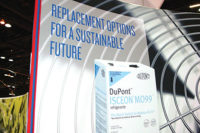
|
| Natural refrigerants such as propane are drawing increasing attention as with this booth display by Embraco at the AHR Expo in Dallas and with its evaluation in an AHRI report. |
Now that the battle regarding ozone depleting potential (ODP) refrigerants has ended with the phaseout of CFCs and HCFCs, the fighting has shifted to issues related to the global warming potential (GWP) of the remaining and newly developing refrigerants.
Remaining Effective
The field of combat not only includes f-gases such as HFCs and HFOs, but also so-called natural refrigerants such as propane, carbon dioxide, and ammonia.
In fact, a GWP line in the sand was drawn a number of years ago in Europe as regulators mandated that automotive air conditioning refrigerants maintain a GWP of less than 150. By contrast, the GWP of HFC-134a — the primary auto a/c refrigerant since 1987, when it replaced CFC-12 — registered at 1,430. Today, the automotive sector is considering switching to HFO-1234yf , which has a GWP of 4 and R-744 (carbon dioxide), which boasts a GWP of 1.
But, how does the long list of refrigerants that can be used in HVACR stack up, not only in terms of GWP but in their effectiveness as refrigerants? That has been the objective of the Air-Conditioning, Heating, and Refrigeration Institute (AHRI) with AHRI Project 8006 — Low Global Warming Potential Refrigerants.
A report of the project’s findings published earlier this year focused on refrigerants HFO-1234yf, propane (R-600a), ammonia (R-717), and carbon dioxide (R-744).
“All of these have low GWP, but some have potential drawbacks such as flammability, toxicity, potentially low efficiency, and/or operating conditions that are very different from those of conventional refrigerants,” states the executive summary of the 52-page report, which was prepared for AHRI by Navigant, an independent consulting service.
The report makes it clear that the industry wants regulators to understand that use of refrigerants cannot be based on low GWP only. This has sometimes been an issue in Europe, where environmental organizations have pressured regulators to focus on low GWP only and not total equivalent warming impact (TEWI) or life cycle climate performance (LCCP), which factors in greenhouse gas emissions if a low GWP refrigerant causes a system to run less efficient.
And, as the industry deals with refrigerants outside the traditional HFCs, the report clearly noted that refrigerant changeover must be clearly defined and noted. “System configurations consistent with safety requirements and performance goals must be defined. Applicable codes and standards contain the relevant safety requirements. The costs and other relevant features of these system configurations (technical risk, suitability for the large replacement market, etc.) must be determined.”
The summary went on to note, “This evaluation provides a first step towards completing such assessments by identifying current applicable codes and standards that would dictate system design requirements, development of the most attractive system configurations compliant with the applicable codes for candidate low-GWP refrigerants, and definition of system configuration design details.”
Here were some of the findings:
R-744: “According to the safety requirements provided in ASHRAE Standard 15 and UL 1995, carbon dioxide systems are not limited in charge size or design. However, carbon dioxide systems must meet general strength requirements for all refrigerant-containing parts, requirements that are more restrictive for carbon dioxide due to the relatively high pressures of a transcritical carbon dioxide system.”
R-717: “According to the safety requirements provided in ASHRAE Standards 15 and 34, and UL 1995, use of ammonia is very restricted in direct systems and not restricted in indirect systems. The driving design requirement is the ASHRAE Standard 34 RCL limits, which only allow very small quantities of ammonia refrigerant in direct systems (compared to typical systems). There are no charge restrictions for indirect systems.”
R-600a: “According to the safety requirements provided by ASHRAE 15, UL 1995, and UL 484, use of propane is highly restricted. ASHRAE Standard 15 does not allow the use of A3 refrigerants in configurations other than portable-unit systems containing up to 150 g of refrigerant, and UL Standard 484 allows certain charge sizes based on the LFL (lower flammability limit) of the refrigerant; for example, up to 150 g of propane in room air conditioners without restriction (consistent with ASHRAE Standard 15 requirements) and up to 1 kg of propane with charge restrictions based on room size. The ASHRAE Standard 15 restriction effectively precludes consideration of the larger charge allowances of UL Standard 484.”
HFO-1234yf: “According to the safety requirements provided in ASHRAE Standard 15 and UL 1995, use of HFO-1234yf is somewhat restricted in direct systems and not restricted in indirect systems. ASHRAE Standard 15 restricts A2 systems from using direct configurations to unit systems using no more than 6.6 pounds of charge. There are no charge restrictions for indirect systems.”
Publication date: 6/3/2013
Want more HVAC industry news and information? Join The NEWS on Facebook, Twitter, and LinkedIn today!







